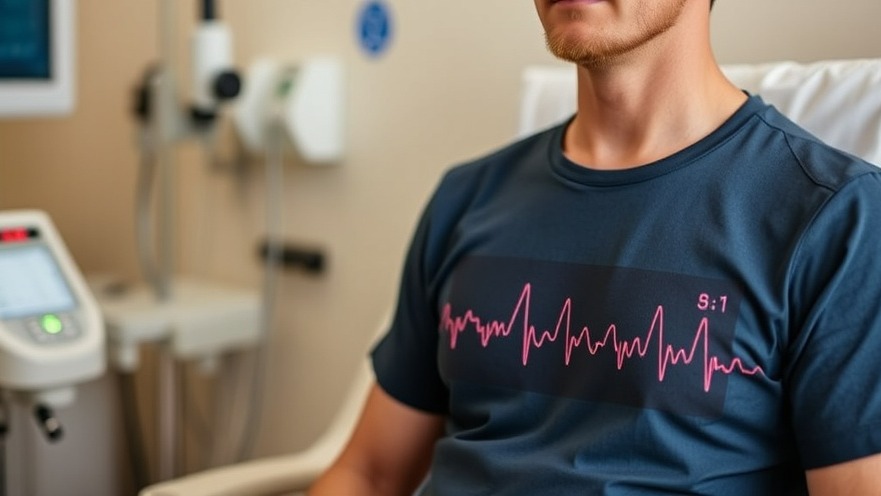
The Wearable Revolution in Postoperative Care
Advancements in wearable technology are making waves in the healthcare sector, prompting innovative approaches to how patients are monitored post-surgery. A pioneering initiative by a research team at Sapienza University of Rome has led to the development of a sensory t-shirt designed specifically for postoperative care after urological surgeries for cancer. With the potential to revolutionize recovery protocols, this device is not just a step towards improved patient comfort but a leap into the future of telemedicine.
Bridging the Gap Between Hospital and Home
The sensory t-shirt is designed for patients shortly after their surgeries, providing a safety net that allows them to recover at home instead of spending extended periods in the hospital. During a recent pilot study showcased at the European Association of Urology (EAU) Congress in Madrid, researchers explored whether early discharge could enhance patient experience without compromising safety. The findings were promising: patients wearing the t-shirt were discharged 24 to 36 hours sooner compared to traditional recovery practices.
How It Works: Sensors and Monitoring
The t-shirt is embedded with advanced sensors that can continuously track vital signs, including ECG, respiratory rate, pulse, body temperature, and even electrolytes, which are crucial for patients recovering from bladder surgery. For two to four hours daily, patients wear this intelligent garment under their clothes, allowing clinicians to monitor their health statuses remotely through an application. Unlike traditional wearables, this t-shirt provides a much broader spectrum of data, enabling healthcare providers to make informed decisions quickly.
Patient Confidence and Early Detection
One of the most significant benefits observed during the study was the heightened sense of reassurance among the wearable group compared to the control group. While 26% of control patients required unplanned hospital visits, only 6% of those wearing the t-shirt had similar needs. Moreover, the t-shirt successfully identified early signs of cardiological conditions in several patients, allowing for timely interventions—an essential factor in post-surgical care. Satisfaction rates soared to 90%, indicating that patients appreciate this technological support.
Implications for Telemedicine and Patient Care
As telemedicine continues to integrate into standard practices, tools like the sensory t-shirt signify a significant shift in how patient care is managed. This device not only optimizes hospital workflows by reducing bed occupancy but also empowers patients by extending their health monitoring into the comfort of their homes. This model fosters a more engaging patient-provider relationship, making health management feel collaborative rather than dictated.
Future Trends: Where Do We Go From Here?
The successes witnessed in this pilot study highlight an emerging trend in healthcare—using technology to enhance recovery processes and improve outcomes. We can expect to see an influx of research-centered, innovative solutions targeting real-world issues faced by patients post-surgery. With ongoing advancements in IoT and AI technologies, future wearables may offer even more comprehensive data analysis tailored to individual patient needs, showcasing the potential for a new era in health monitoring.
Addressing Concerns and Misconceptions
While the benefits of such wearable technology are evident, it's essential to address potential concerns among both patients and healthcare providers. The complexities of telemedicine can lead to misunderstandings or skepticism regarding the technology's reliability. Educating practitioners and patients about how these devices function and the data they produce will be necessary for broader acceptance. Continuous feedback loops and training can alleviate doubts and maximize the device's utility in real-world settings.
Engaging Healthcare Providers
Concierge health practitioners and those in integrated care models can significantly benefit from understanding this technology. By incorporating patient education and training about these devices, practitioners can enhance patient trust and satisfaction in post-operative recovery processes. This could lead to a reduction in readmission rates, providing an overall better experience for both patients and providers.
In conclusion, as the contactless future of medicine evolves, embracing wearable technology like the sensory t-shirt can reshape how recovery is approached post-surgery. By prioritizing patient monitoring, safety, and comfort, healthcare practitioners will not only improve outcomes but also set the stage for a more connected and efficient healthcare system.
By effectively implementing such innovations, you, as a healthcare provider, stand to transform the lives of patients in your care. Explore these technologies and advocate for their usage to promote better health outcomes.
 Add Row
Add Row  Add
Add 






Write A Comment